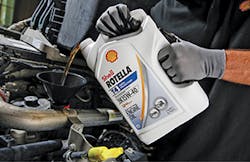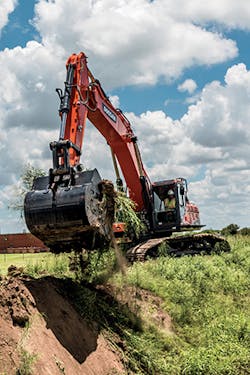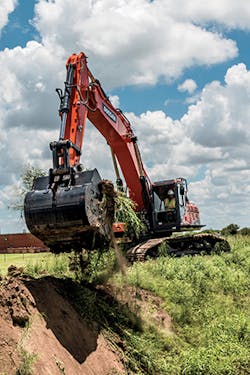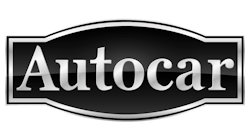The US Environmental Protection Agency’s (EPA) Tier 4 emission standards have changed the rules for the engines that power both on-highway and off-road equipment, including the trucks and vehicles that move earth on grading and excavation jobs.
But the makers of the lubricants that keep these engines running say that owners and operators are making the change to higher-grade oils with few, if any, hiccups. The reason? The new oils designed to meet the Tier 4 emissions standards are backwards-compatible, meaning that owners and operators can use them in both newer off-road vehicles and older ones. That makes the switch to these new oils a simpler process.
The benefits of the new lubricants are impressive. Vehicles, both off-road and on-highway, powered by the Tier 4 engines will emit far fewer emissions. And the more advanced oils that keep these engines running will help reduce the amount of fuel that fleets consume each year, resulting in solid, bottom-line savings for grading and excavation contractors.
Advanced lubricants, then, are positives for both air quality and the profits of grading and excavation contractors.
New standards
The new Tier 4 emission standards were phased in from 2008 through 2015. The standards went into effect for off-highway vehicles in January of 2014.
The change to Tier 4 has had an immediate impact in the type of lubricants the owners of construction machines need to use to keep these machines’ new engines running smoothly.
Dan Arcy, OEM technical manager with Shell Global Solutions, says the move to Tier 4 engines requires owners and operators to lube their vehicles with oils that come with low levels of sulfated ash, phosphorous, and sulfur.
The good news? Lubricant companies have not struggled to produce these new oils. That’s because the off-highway market tends to lag behind advancements already made in on-highway engines. The engines powering on-highway vehicles already had to meet Tier 4 standards in 2007, and a second round of Tier 4 regulations in 2010.
Manufacturers such as Shell already had the formula for the oil that off-highway vehicles with Tier 4 engines now use.
“From a Shell standpoint, our portfolio was already there,” says Arcy. “We already had oil that met the standards that Tier 4 engines in off-highway vehicles have to meet.”
Lower impact
Kenneth Tyger, senior technical manager OMA I, OMA II with D-A Lubricant Company Inc. said that two main words are key for the Tier 4 requirements: reduced emissions. To get to these lower emission levels, engines require the use of oils designed with reduced SAPS—sulfated ash, phosphorous, and sulfur—to protect the after-treatment emission control devices on them, such as diesel particulate filters and catalytic converters.
Low-SAP oils are better equipped to handle the significantly increased soot that results from the higher recirculation levels of higher-exhaust gas.
“All these technologies depend upon a motor oil that provides the required equipment protection, longevity, and overall expected performance,” says Tyger.
Engine oils that are not specifically designed for use with Tier 4 after-treatment devices can plug diesel particulate filters, which can cause excessive regeneration and reduced equipment life. Using the wrong oils with today’s newer engines can also cause the possible poisoning of catalyst media in addition to a loss of efficiency with the bulldozers, shovels, and graders that contractors use on road and excavation projects.
The best rule for contractors to follow is a simple one: older oils, such as the American Petroleum Institute (API) CH-4 or CI-4 levels, are not recommended or suitable for use in modern Tier 4 diesel engine hardware. This hardware, instead, requires newer oil types: either API CJ-4, which has been the modern standard for high-efficiency, low-emission oil for about a decade, or, the newest of the oil types, API CK-4.
New emission standards for heavy-duty engines from the EPA were phased in between the years 2007 and 2010. To help meet these standards, the engines of these vehicles were fitted with more advanced emission-control equipment. Of particular importance are the diesel particulate filters and exhaust gas recirculation systems that come with the new engines.
API CJ-4 oil was designed specifically to work with these new systems. By using this type of oil, manufacturers are more able to guarantee that the engines powering their vehicles are working to their maximum efficiency, while meeting all upgraded emissions requirements.
Both of these goals are important. Contractors, of course, want their vehicles to operate as efficiently as possible. That’s a simple bottom-line plus. But they also need to meet emission requirements. If they don’t, they can face heavy penalties that can hurt their yearly profits.
Doosan DX530 LC-5 with Tier 4 emissions
Durability and Performance
The American Petroleum Institute says that API CJ-4 oils, when used in engines running on ultra-law sulfur diesel fuel, are critical for the durability and performance levels of engines built in 2007 and later. The Institute, though, says that owners aren’t limited to using CJ-4 oil in newer engines. Owners can use the oil in their older machines, too, without worrying about damaging their engines. This makes switching to the new oil type a less onerous process for contractors who have a fleet mixed with both older and newer vehicles.
Oil standards are constantly evolving. That’s why in 2016, the petroleum institute introduced two new oil standards: API CK-4 and API FA-4. These new oils were available starting December 1 of last year.
API CK-4 oil is designed for high-speed four-stroke cycle diesel engines in on-highway vehicles. Fortunately, this isn’t much of a change for the owners and operators of off-highway vehicles. No new emission standards have been introduced for off-highway vehicles in the recent past. The owners and operators of these vehicles can continue using CJ-4 oils in their Tier 4 engines without worrying about not meeting federal emissions regulations.
Tony Negri, product manager with ConocoPhillips Lubricants, says that the new upgrade to CK-4 oil won’t have much of an impact at all on the owners and operators of off-highway grading and excavation vehicles. The CK-4 lubricants are completely back-serviceable, meaning that owners and operators can use the oil in any of their vehicles, even those with older engines, without reducing performance.
“It’s kind of a ‘no-change’ change,” says Negri.
Tier 3 Engines Still Out There
Not all the owners and operators of off-highway construction equipment have made the switch to newer oils, of course. Many are still handling their grading and excavation projects with vehicles powered by Tier 3 engines. For these owners, the upgrade to oils meeting higher efficiency and emissions standards is not yet a necessity.
Although, the number of contractors who aren’t using at least some Tier 4 off-highway vehicles is dropping.
Those who do make the switch to Tier 4 engines and higher-grade oils will see fuel savings. Officials with Shell Lubricants say that over the last five years, they have documented projects that delivered more than $139 million in customer savings because these customers eventually improved their lubrication processes. This could mean that the customers upgraded to higher-grade oils, discovered a flaw in their lubrication processes, or changed their oil-change intervals.
Shell officials say that these charted savings represent only a small portion of the real total—a figure that Shell says could be as much as 10 times higher.
As an example of real world cost savings, Shell points to the Sasan coalmines in India. Shell Lubricants supplied these mines with its lubricant products in addition to lubricant management services. During a routine inspection, Shell Lubricants inspectors found a fault with a section of the lubrication system on one of the company’s shovels.
The lower load and carry rollers on both sides of the crawler were dry, and the system did not appear to be pumping the required amount of grease to the rollers.
Shell conducted a series of tests to find the root cause of this problem. Opening the return line of the pump and operating it manually showed that the grease was returning to the tank after only a few seconds. That indicated damage to the needle and seat of the vent valve.
Shell’s technicians recommended changing the vent valve and installing a new pump. This resolved the issue, ensuring that grease could reach the injectors and travel to the rollers in the correct volume.
In another case study, South African mining company BECSA Wolvekrans was experiencing drastically shortened component life with the hoist bull gear and pinion of one of its draglines. The expected life of a pinion is four years, while it is eight years for a bull gear. But after just 18 months, the hoist pinion failed when a tooth broke off. Two weeks after a new hoist pinion was fitted, inspection by Shell Lubricants technicians revealed plastic defamation, or rippling, on the contact surface of the pinion.
Rippling reduces the contact surface, leading to excessive stress on the components and increased risk of breakdowns.
What caused the rippling here? Shell Lubricants technicians found that the initial rippling resulted from improper run-in when both the hoist pinion and bull gear were replaced. These ripples were left on the bull gear when the old pinion was replaced and transferred to the new pinion while under load during operation.
Shell recommended applying a lapping compound to smooth and grow the contact surface. This helped increase the load-carrying area of the gears, reducing stress and fatigue and extending the life of the gear set.
Thanks to Shell Lubricants’ diagnosis, a second breakdown of the equipment was averted. This helped avoid costly repairs and the purchase of replacement components. It also avoided any lost production time. The mining company reported total savings of more than $1.2 million.
According to Shell Lubricants, effective lubrication can save mining companies 20% to 30% in total maintenance costs of their equipment each year.
Effective lubrication doesn’t just save mining companies money, of course. It also can provide significant savings to all grading and excavation contractors in the form of reduced downtime, fewer trips to the repair shop for their heavy-duty vehicles, and lowered fuel costs.
Dan Arcy with Shell Lubricants says it’s not easy to give an exact figure for how much money grading and excavation contractors can save each year by lubricating their vehicles properly. But he said that contractors that go from a lower grade to higher-grade motor oil could reduce their fuel consumption by 1.6%.
“When you look at what the average owner/operator uses in a given year, they will burn upwards of about 15,000 gallons to 20,000 gallons of fuel a year,” estimates Arcy. “Moving to a lighter-weight oil puts dollars directly in their pocket. A lot of the big fleets have realized this. If you have a trucking fleet that has thousands of tractors out there, the numbers get big real quick.”
More Complex Engines
While Tier 4 engines are designed to reduce emissions, they also come with new parts. Maintenance personnel need to understand how these added components—most of which have been added to lower the emissions generated by these engines—work, and what steps they must take to keep these parts operating properly.
If maintenance staffers, owners, and operators ignore these new components, they might discover that their vehicles and onsite equipment will break down more frequently—costing them valuable uptime.
“Engines might not operate properly if issues develop with these systems,” adds Tyger.
There are some misconceptions among contractors regarding Tier 4 engines. Owners and operators have asked Tyger if they’ll need to increase the filtration requirements on fleet diesel vehicles and equipment to meet Tier 4 requirements.
Tyger says the question is flawed because filtration won’t dilute the concentration of sulfur in diesel fuel, even if Tier 4 specified filtration changes, which it doesn’t.
“Many believe a filter will reduce sulfur content in diesel fuel to make it low-sulfur or Tier 4 compatible,” explains Tyger. “My answer has long been that I am not aware of any changes in fuel filtration as related to Tier 4, and that the sulfur concentration of the diesel fuel cannot be reduced using filtration.”
He does, though, caution users of relying on older oil types with higher SAPs in Tier 4 equipment. Contractors who do this will actually lose money as these older oils cause problems in today’s newer engines.
“That is always a concern,” says Tyger. “Many believe oil is oil, and will not think twice about utilizing older API heavy diesel chemistry in modern Tier 4 equipment. That is a mistake that can hurt the performance of these machines and cause problems down the road.”
Before 2006–2007, diesel engines did not possess the multiple emissions systems found on today’s workhorse vehicles. Owners and operators who insist on using older oils for these newer vehicles will notice a reduction in efficiency—and that will cost them plenty of money over the long-term.
Maintenance Matters
Lubricants do more than just reduce emissions and fuel consumption, of course. They also help owners keep their vehicles running and out of the repair shop. Proper lubrication is the most important step owners can take in maintaining the health of their off-highway equipment.
The majority of owners do a good job following their vehicles’ lubrication standards. They know that by doing this, they are keeping their off-highway equipment on the job site and out of the repair bays.
“I’ve worked with a lot of owner/operators. When it comes to maintaining their vehicles, the ones I’ve worked with treating their machines as if they were their babies out there,” recalls Arcy. “They are very intimate with making sure everything that needs to be done is taken care of. The ones I’ve worked with are very much in touch with the maintenance needs of their vehicles. They want to know all the changes in lubrication being made. They want to know what they can do to make their vehicles last as long as they can.”
Lubricants, of course, pull out any contaminants that have gotten into vehicle engines—something that also prolongs the life of this equipment. Plenty of soot is generated through the combustion process. By changing their oil, owners not only give their vehicles the benefit of fresh lubrication, they are also removing those contaminants from their engines.
“That is a very big key in maintenance and in squeezing a long life out of an engine,” advises Arcy.













